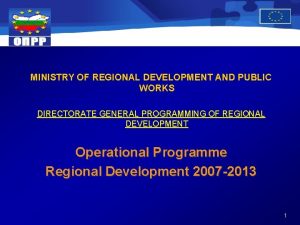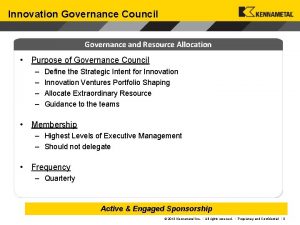Regional Development and Governance Symposium Innovation Enhancement in










- Slides: 10

Regional Development and Governance Symposium Innovation Enhancement in Slovenian Regions Tadeja Colnar Leskovšek Anteja ECG Izmir, 26 October 2007

What does it take for region to become innovative? Infrastructure conductive to Innovation Conditions for Innovation Fostering Education system Competition DIVERSITY SHARING role models INNOVATION CONCEPTS divergent NEW INTERACTIONS Administrative simplification Protection of intelectual and industrial property CONSENSUS BUILDING LEADERSHIP Taxation convergent INNOVATIVE REGIONS vision strategy action Legal and regulatory environment

Cluster program for innovation enhancement

Cluster program was part of proactive industrial policy Internationalization of SME Improving enterprises’ competitive capacity (4 measures) Investment in technological development Increasing productivity Networking and cluster development Innovative environment

… starting with mapping … … which indicated: • Linking and networking was relatively weak. • Geographical (regional) dimension was not clear dispersed throughout Slovenia. • Infrastructure which could support cluster development was only emerging. • Existing co-operations and flows could represent a basis for at least nine potential clusters. Which cluster is strategic for Slovenia? How to develop clusters?

. . . followed by measures to respond to identified needs. From supporting strategic clusters to a set of horizontal policy measures Measures aiming at • Promoting cooperation and networking between companies and R&D institutions • Developing clusters in practice – Pilot Projects Objectives: • To gain experiences and develop knowledge • To strengthen linkages along supply chains • To strengthen linkages between R&D and business • To promote cluster concept

Results achieved from 2001 to 2004 were encouraging … 17 clusters - networking of more than 300 enterprises (57. 000 employees) and 40 support institutions, 4 technological networks - networking of 43 enterprises (30. 000 employees) and 15 support institutions, 29 technology centers - co-operating of 240 enterprises, 53 enterprises (22. 700 employees) introducing the system for continuous improvement in production, processes and technology.

Key success factors Clear roles and competencies • Ministry of Economy acted as catalyst of the clustering process – Providing co-financing of startup costs (40%) of cluster initiatives (management, projects) – Analysis – Facilitation – Training – International networking

Key success factors Balanced Top Down And Bottom Up Process • Bottom-up process: – Measures not replacing market mechanism. – Decisions about areas (industries) of cluster development, organizational and managerial issues are domain of participating actors (firms and institutions). – No Constrains, no strict Rules, no guided Strategies. – Initiative and responsibility for success of business and clustering remain domain of managers, employees and individuals.

Major challenge in implementing cluster policy … … how to create trusting environment • Public policy cannot be developed in the absence of strong public private partnership, which in return, can not be developed without the culture of trust. • Trust is needed between partners, between employers and employees between boards and shareholders, and between state and citizens.
 Arnim wiek
Arnim wiek Innovation for the sake of innovation
Innovation for the sake of innovation Radical innovation vs disruptive innovation
Radical innovation vs disruptive innovation Ministry of regional development and public works
Ministry of regional development and public works Ministry of regional development and public works
Ministry of regional development and public works Entrepreneurship and regional development
Entrepreneurship and regional development Centre for learning enhancement and research
Centre for learning enhancement and research Listening and communication enhancement
Listening and communication enhancement Environmental enhancement and mitigation program
Environmental enhancement and mitigation program Rdi research development innovation
Rdi research development innovation Action wageningen
Action wageningen


















